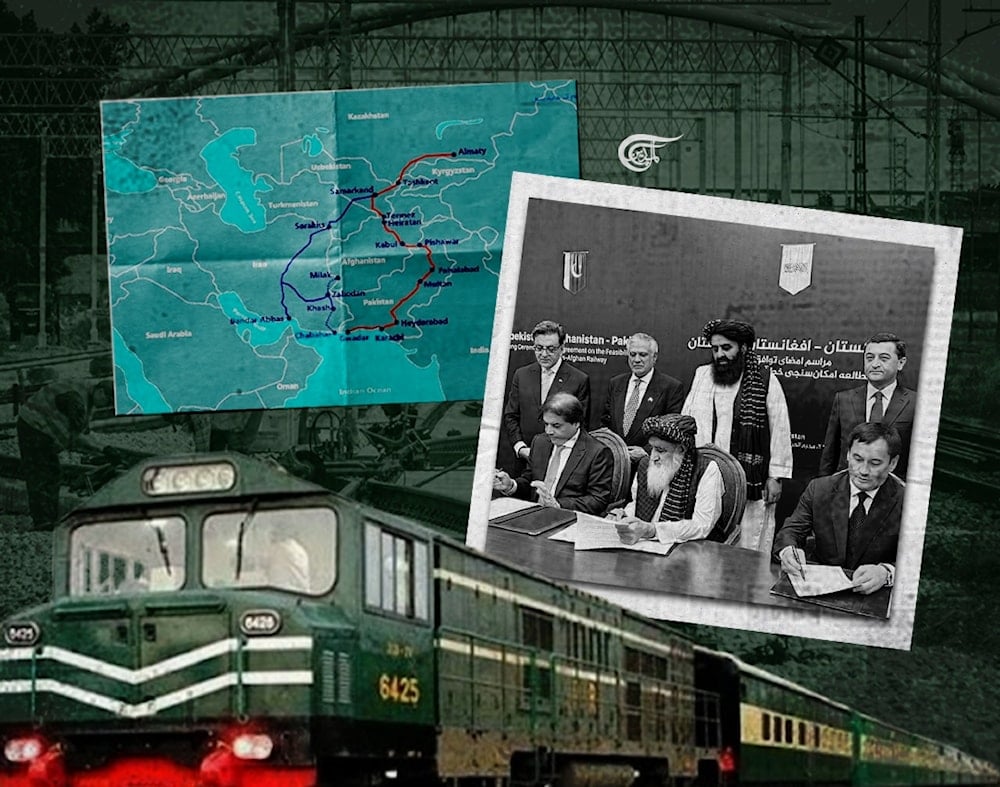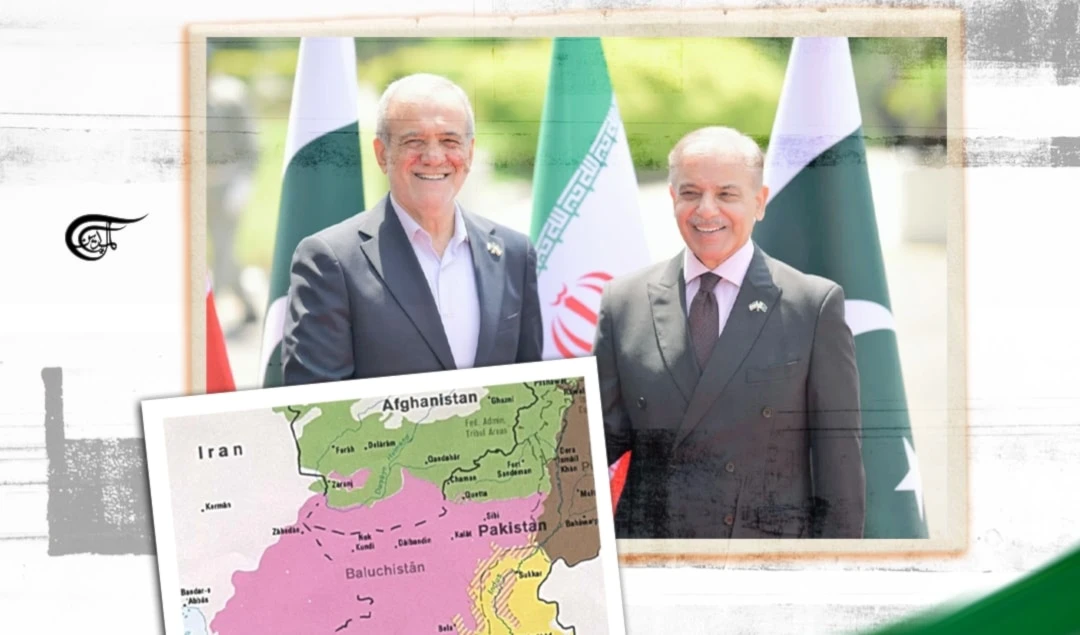Trans-Afghan Railway Corridor set to change regional trade landscape
Uzbekistan, Afghanistan, and Pakistan just signed on to the $4.8B Trans-Afghan Railway, aiming to slash trade costs by up to 40% and connect Central Asia to Arabian Sea ports; will it work or remain a dream?
-

Trans-Afghan Railway project has made it easier to connect Uzbekistan, Pakistan, and Afghanistan via land (Illustrated by Zeinab al-Hajj for Al Mayadeen English)
A recent boost to the Trans-Afghan Railway project has made it easier to connect Uzbekistan, Pakistan, and Afghanistan via land.
In a signing ceremony that took place in Kabul on July 17, the three nations finally agreed on the vital corridor, which is a major step forward. As a result of their agreement on the route, the three countries will now begin a feasibility study for the Naibabad-Kharlachi rail link. This project will link Peshawar, Tashkent, and Kabul and will eventually expand to the ports of Gwadar and Karachi. Estimates put the project's final cost at $4.8 billion.
Deputy Prime Minister Ishaq Dar, together with the railway minister and senior officials, travelled to Kabul to take part in a trilateral meeting about the recent expression of Pakistan's intention to speed up the completion of the Uzbek-Afghan-Pakistan (UAP) Railway Corridor.
Blueprint for tying regions together
Uzbekistan’s approach to Afghanistan is not just a hand extended for relief and trade, but a daring blueprint for reshaping the landscape of regional integration. The crown jewel of this agenda is the Uzbekistan-Afghanistan-Pakistan Railway, famously dubbed the Trans-Afghan Corridor. This rail line is set to hit the ground running, connecting the dots between Central Asia and Pakistan’s bustling Karachi and Gwadar ports on the Arabian Sea, all while making its way through Afghanistan.
In May 2023, Uzbekistan rolled out the red carpet for a project office aimed at steering the railway construction in Tashkent, with branches sprouting up in Kabul and Islamabad.
By July, the final route, Termez-Naibabad-Logar-Kharlachi, was set in stone, and in August, the first freight cars rolled into the Naibabad station, spruced up by Uzbekistan, signaling a big leap in regional connectivity. Last year, Uzbekistan put pen to paper with Afghanistan and the United Arab Emirates to kick off a feasibility study for the Uzbekistan-Afghanistan-Pakistan Railway.
With construction set to kick off this year, the railway line, stretching a whopping 648 kilometers and carrying a price tag between $4.8 billion and $6 billion, is anticipated to wrap up within five years.
This railway corridor is expected to reduce the transportation costs to and from Indian Ocean ports when operationalized. It will slash the cost by 30–40 percent. By the time it hit the ground running in 2030, the annual freight volumes might soar to 22 million tons, reaching 34 million tons by 2040. Afghanistan is set to handle more than 20 percent of this cargo.
Regional trade interactions
Uzbekistan, Afghanistan, Pakistan, China, and Russia had inclusive trade connectivities with each other. In recent years, Uzbekistan's bilateral trade volume with Afghanistan has been on the upswing, steadily climbing with the passage of time.
The figures rolling in from the Uzbekistan Ministry of Investment, Industry, and Trade show that Afghanistan has become Uzbekistan’s fifth-largest export market. In 2023, the two-way trade hit a whopping $866 million. By 2024, it had ballooned to $1.1 billion, thanks to Uzbek exports. The two countries are looking to bump this figure up to $3 billion in the not-so-distant future.
Similarly, Pakistan is mainly interested in improving its connections with Central Asia for geopolitical and economic reasons. Some examples of this include the possibility of energy alliances, expanded trade, and entry into new markets. Pakistan plans to take advantage of its strategic location to open up trade and transit opportunities with Central Asian countries and beyond, especially through initiatives like the China-Pakistan Economic Corridor (CPEC).
Likewise, the latest figures from China's General Administration of Customs (GTU) reveal that Beijing's exports to Central Asia reached approximately 286.42 billion Yuan ($39.93 billion) in the first half of 2025, setting a new record compared with corresponding periods in the previous years.
In the first five months of this year, China has opened its wallet wide, bringing in agricultural products from the five Central Asian countries to the tune of 4.36 billion Yuan, marking a hearty 26.9 percent leap compared to last year. Among these, imports of flaxseed from Kazakhstan skyrocketed by 202.1%, raisins from Uzbekistan blossomed by 153.7%, and honey from Kyrgyzstan experienced a jaw-dropping surge of 10.9-fold.
Establishing a reliable railway corridor would undoubtedly enhance China's competitiveness by facilitating smoother and more economical goods transportation from the Central Asian States.
Political/trade circle apprehensions
However, the lawmakers in Peshawar are raising eyebrows about the project's viability, given Islamabad's current financial pickle. Questions hang in the air regarding whether the Pakistani establishment can truly chart its course and put the economic welfare of the everyday citizen front and center.
As per the words of former senator and a leader of the Pakistan People's Party (PPP), Zahid Khan, this initiative is more of a pie in the sky and is likely to be just a distant dream until Pakistan can take the bull by the horns and carve out its economic policies, tailored to its one-of-a-kind regional circumstances.
He tells Al Mayadeen English, "Such projects are merely a smoke and mirrors act to divert the public's ire from the harsh truths, especially when the economy is hanging by a thread and the masses are hitting the streets to voice their discontent over skyrocketing food prices and bloated power bills."
Khan further emphasizes that Islamabad's reputation took a hit when it pulled the rug out from under the Iran-Pakistan (IP) gas pipeline project and turned its back on Russia's crude oil imports, all while the nuclear-armed nation wrestled with an ongoing energy crisis.
In an interview for Al Mayadeen English, Zia Ul Haq Sarhadi, who is a director and coordinator of the Pakistan-Afghan Joint Chamber of Commerce and Industry (PAJCCI), remarked that the entire kit and caboodle of Southeast Asia and the Middle East (West Asia) getting snug with Central Asia and the Caucasus hinges on Afghanistan and Pakistan.
“If they can tie up the loose ends on the Trans-Afghan Railway Line, it will be a real turning point for a united Eurasia. There’s a burning need for the regional countries to hop on the bandwagon with this new corridor and lay their reservations to rest. Addressing their concerns and clarifying the facts is critical for making sure that this railway link becomes a vital component of regional trade, uniting China, Iran, Pakistan, Russia, Afghanistan, and the Central Asian countries," he added.
Who will bell the cat?
The Trans-Afghan Railway project faces significant financial challenges due to the inability of any single entity to meet the multi-billion-dollar requirement. Together, the three groups approached international financial institutions and the United States' International Development Finance Corporation (DFC) in 2020 to request project finance. Nevertheless, conflicting figures surfaced, drawing attention to the financial difficulty: Tashkent estimated $4.6 million, while Islamabad put out a considerable $8 billion.
The Taliban have multiple objectives in reaching out to Russia and Kazakhstan, one of which is to advance regional connectivity via the Trans-Afghan Railway project. In addition to establishing a foundation for deeper ties between these states, this undertaking pushes Kabul closer to profitable export markets in Central Asia.

 F.M. Shakil
F.M. Shakil
 7 Min Read
7 Min Read









